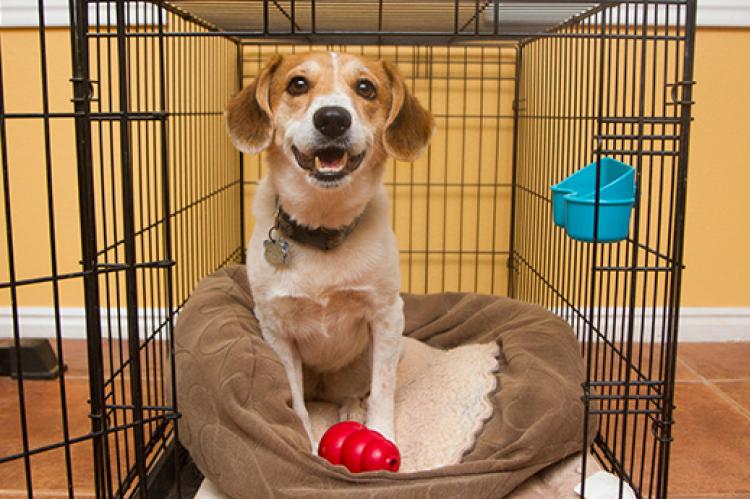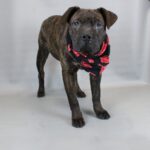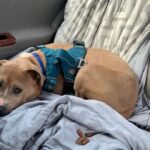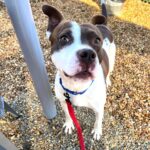
Source: Rhonda Bilodeau | Vermont Dog Pack
Are you finding yourself with a newly adopted dog that is starting to show signs of fear, defiance or anxiety around the crate? Follow these directions to help your dog feel secure and confident getting in the crate and staying in the crate for long periods while you’re away.
First step is deciding if;
1) Your dog is being defiant because they would prefer to not be in the crate.
2) They have separation anxiety (where they panic when alone or away from their person or persons)
or 3) They have kennel confinement phobia.
How can you tell if it’s option 1, 2, or 3?
Option #1 : Defiance
A defiant dog is one that runs away if you try to put them in the crate but is able to settle down after a few minutes in the crate. They can relax without additional support from you and are not being destructive to their crate, bedding, toys or themselves when you leave. They also don’t bark, cry, whine, pant, drool, etc after those few minutes.
Solution: Play crate games and always reward for going in the crate. Keep a light leash on them in the house. Tell them to “kennel up” or “crate” and if they run away, bring them to the crate and reward them for going in. You may have to pull them in. They should always get a reward for going in the crate. Be matter of fact and keep the conversation to a minimum. Just use “Kennel up” or “crate” and then stop talking and help them inside the crate. Keep nice tasty treats on top of the crate so you don’t forget. You may find blocking their view of you coming and going helps. Use a wall or a blanket that covers the crate. Never keep anything in the crate except for a kong toy with frozen peanut butter in it. Anything else they can destroy and possibly harm themselves.
Option #2 : Separation Anxiety
Dogs with separation anxiety have a fear of being left alone or a fear of being away from you. This fear, when drawn out, becomes anxiety. You must stop the constant glances at you and following you from room to room because it’s unhealthy for dogs to constantly be alert to their people’s movements out of fear.
Solution: Help your dog turn off their sympathetic system (fight or flight response) and turn on their parasympathetic system (rest and relaxation). You can help your dog rest and relax more by purchasing a Treat and Train remote feeder or a Furbo. A Furbo is nice because you can toss treats while at work to help them relax and monitor their behavior. The Treat and Train does not have this option as you have to be in the same house as the remote feeder but has a remote that’s easy to carry and easy to dispense a treat to the dog with. Remote feeders will also help defiant dogs learn to love their crates and confinement phobia dogs learn to relax out of their crate. Place the remote feeder in the dog’s crate and free shape to the crate (free shaping is successive approximation, a series of rewards that provide positive reinforcement for behavior changes that are successive steps towards the final desired behavior – like potty training a child). Practice free shaping your dog to the crate and then free shape a mental state – relaxation. Reward for emotionally relaxing until they’re totally relaxed. Practice this all day especially when you’re leaving the room and walking around. You can also reward your dog for not staring at you. We want our dogs to relax instead of feeling like they need to follow us around the house.
Eventually you’ll be shutting the door to the crate once they love their crate. Once closed free shape relaxation in the crate while you’re in the same room. As your dog becomes really good at relaxing in their crate with the door shut you can start to make short trips out of the room away from them. Rewarding heavily for relaxing inside the crate. Leave for longer periods and when you come back keep rewarding for relaxation. Never let your dog out of the crate unless they’re relaxed. We want our dogs to connect their relaxed behavior with getting out of the crate. Never keep anything in the crate except for a kong toy with frozen peanut butter in it. Anything else they can destroy and possibly harm themselves.
Option #3 : Kennel Confinement Phobia
You know your dog has kennel confinement phobia when you can’t crate them even when you’re home because they seriously injure themselves.
Solution: Usually Kennel Confinement Phobia dogs do much better out of their crate. Choose a large area of the house you will be barricading off. Follow the steps in Option #2 (separation anxiety dogs) but free shape to the large space you will be keeping them in so they learn how to relax around the house when you’re away. You can still free shape to the crate and make a slow progression to closing the door but your dog may never be okay with the door closed. You may find a dog with kennel confinement phobia will never be able to be confined without a long history of training around the crate. Keep the house picked up so they don’t ingest anything while you’re away. Always monitor with a Furbo camera and support them with food to relax them when needed.
We work with separation anxiety cases every day with success. If you are in need of a behavioral trainer please reach out to us! VermontDogPack.com
















